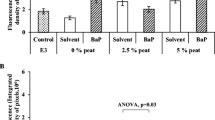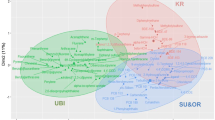Abstract
The internal critical concentration represented by the critical body residue (CBR) is an ideal indicator for reflecting the toxicity of a chemical. Although some authors have realized that the CBR50 can be calculated from the LC50 via the bioconcentration factor (BCF), the effects of exposure time and exposure concentration on the relationship between the LC50 and CBR50 have not been investigated to date. In this paper, the LC50 and CBR50 of ortho-dinitrobenzene in zebrafish were experimentally determined and their relationship was investigated. The results showed that ortho-dinitrobenzene exhibited excess toxicity and cannot completely be identified as a reactive compound based on toxic ratio. Comparison of the measured CBR50 and the CBR50 calculated from the LC50 via the BCF showed that there was a 0.46 log unit difference. Investigation of the relationship between the concentration in fish calculated by the toxicokinetic model and exposure time showed that the bio-uptake of fish was fast and reached a steady state in the toxicity test, indicating that the difference in CBR50 values could not be attributed to the different exposure times used in toxicity and BCF assays. On the other hand, investigation of the measured bioconcentration ratio (BCR) showed that the BCR (or BCFapp) decreased with increasing exposure concentration. Compared with the CBR50 calculated from the LC50 via the BCF, the CBR50 calculated from the LC50 via the BCFapp is close to the measured CBR50, suggesting that the difference in CBR50 values is attributed to the different exposure concentrations used in the BCF and toxicity assays.


Similar content being viewed by others
References
Arnot JA, Gobas FAPC (2004) A food web bioaccumulation model for organic chemicals in aquatic ecosystems. Environ Toxicol Chem 23:2343–2355. https://doi.org/10.1897/03-438
Bacchetta C, Rossi A, Ale A, Campana M, Parma MJ, Cazenave J (2014) Combined toxicological effects of pesticides: a fish multi-biomarker approach. Ecol Indic 36:532–538. https://doi.org/10.1016/j.ecolind.2013.09.016
Bajot F, Cronin MTD, Roberts DW, Schultz TW (2011) Reactivity and aquatic toxicity of aromatic compounds transformable to quinine-type Michael acceptors. SAR QSAR Environ Res 22(1/2):51–65. https://doi.org/10.1080/1062936X.2010.528449
Burden N, Creton S, Weltje L, Maynard SK, Wheeler JR (2014) Reducing the number of fish in bioconcentration studies with general chemicals by reducing the number of test concentrations. Regul Toxicol Pharmacol 70:442–445. https://doi.org/10.1016/j.yrtph.2014.08.008
Chaisuksant Y, Yu Q, Connell D (1997) Internal lethal concentration of halobenzenes with fish (Gambusia affinis). Ecotox Environ Safe 37:66–75. https://doi.org/10.1006/eesa.1997.1524
Escher BI, Fenner K (2011) Recent advances in environmental risk assessment of transformation products. Environ Sci Technol 45:3835–3847. https://doi.org/10.1021/es1030799
Escher BI, Hermens JL (2004) Internal exposure: linking bioavailability to effects. Environ Sci Technol 38:455–462. https://doi.org/10.1021/es0406740
Kühnert A, Vogs C, Altenburger R, Küster E (2013) The internal concentration of organic substances in fish embryos-a toxicokinetic approach. Environ Toxicol Chem 32:1819–1827. https://doi.org/10.1002/etc.2239
Landrum PF, Gossiaux DC, McElroy M, Robinson S, Begnoche L, Hickey J, Steevens JA (2004) Time-dependent lethal body residues for the toxicity of phentachlorobenzene to Halella Azteca. Environ Toxicol Chem 23:1335–1343. https://doi.org/10.1897/03-164
Landrum PF, Steevens JA, McElroy M, Gossiaux DC, Lewis JS, Robinson SD (2005) Time-dependent toxicity of DDE to Hyalella Azteca. Environ Toxicol Chem 24:211–218. https://doi.org/10.1897/04-055r.1
Lee JH, Landrum PF, Kon CH (2002) Toxicokinetics and time-dependent PAH toxicity in the amphipod Hyalella Azteca. Environ Sci Technol 36:3124–3130. https://doi.org/10.1021/es011201l
Li Y, Li M, Shi JQ, Yang X, Wang ZY (2012) Hepatic antioxidative responses to PCDPs and estimated short-term biotoxicity in freshwater fish. Aquat Toxicol 120-121:90–98. https://doi.org/10.1016/j.aquatox.2012.04.016
Mackay D, Fraser A (2000) Bioaccumulation of persistent organic chemicals: mechanisms and models. Environ Pollut 110:375–391. https://doi.org/10.1016/s0269-7491(00)00162-7
Mackay D, McCarty LS, Arnot JA (2014) Relationships between exposure and dose in aquatic toxicity tests for organic chemicals. Environ Toxicol Chem 33:2038–2046. https://doi.org/10.1002/etc.2649
McCarty LS (1987) Relationship between toxicity and bioconcentration for some organic chemicals. I. Examination of the relationship. In: Kaiser KLE (ed) QSAR in environmental toxicology-II. D Reidel Publishing Co, Dordrecht, pp 207–220
McCarty LS, Mackay D (1993) Enhancing ecotoxicological modelling and assessment: body residues and modes of toxic action. Environ Sci Technol 27:1719–1728. https://doi.org/10.1021/es00046a001
McCarty LS, Mackay D, Smith AD, Ozburn GW, Dixon DG (1992) Residue-based interpretation of toxicity and bioconcentration QSARs from aquatic bioassays: neutral narcotic organics. Environ Toxicol Chem 11:917–930. https://doi.org/10.1002/etc.5620110705
McCarty LS, Mackay D, Smith AD, Ozburn GW, Dixon DG (1993) Residue-based interpretation of toxicity and bioconcentration QSARs from aquatic bioassays: polar narcotic organics. Ecotox Environ Safe 25:253–270. https://doi.org/10.1006/eesa.1993.1024
McCarty LS, Landrum PF, Luoma SN, Meador JP, Merten AA, Shephard BK, van Wezel AP (2010) Advancing environmental toxicology through chemical dosimetry: external exposures versus tissue residues. Integr Environ Assess Manag 7:7–27. https://doi.org/10.1002/ieam.98
Meador JP (2006) Rationale and procedures for using the tissue-residue approach for toxicity assessment and determination of tissue, water, and sediment quality guidelines for aquatic organisms. Hum Ecol Risk Assess 12:1018–1073. https://doi.org/10.1080/10807030600801535
Meador JP, McCarty LS, Escher BI, Adams WJ (2008) 10th anniversary critical review: the tissue-residue approach for toxicity assessment: concepts, issues, application, and recommendations. J Environ Monit 10:1486–1498. https://doi.org/10.1039/b814041n
Meador JP, Adams WJ, Escher BI, McCarty LS, McElroy AE, Sappington KG (2011) The tissue residue approach for toxicity assessment: findings and critical reviews from a society of environmental toxicology and chemistry pellston workshop. Integr Environ Assess Manag 7:2–6. https://doi.org/10.1002/ieam.133
Neely WB, Branson DR, Blau GE (1974) Partition coefficients to measure bioconcentration potential of organic chemicals in fish. Environ Sci Technol 8:1113–1115. https://doi.org/10.1021/es60098a008
Neuwoehner J, Zilberman T, Fenner K, Escher BI (2010) QSAR-analysis and mixture toxicity as diagnostic tools: influence of degradation on the toxicity and mode of action of diuron in algae and daphnids. Aquat Toxicol 97:58–67. https://doi.org/10.1016/j.aquatox.2010.08.009
Organization for Economic Cooperation and Development (OECD), (1992) Guideline for testing of chemicals: fish, acute toxicity test. Paris.
Organization for Economic Cooperation and Development (OECD), (2012) Bioaccumulation in fish: aqueous and dietary exposure. Paris.
Ramos EU, Meijer SN, Vaes WHJ, Verhaar H (1998) Using solid-phase microextraction to determine partition coefficients to humic acids and bioavailable concentrations of hydrophobic chemicals. Environ Sci Technol 32:3430–3435. https://doi.org/10.1021/es980274a
Ramos S, Amorim E, Elliott M, Cabral H, Bordalo AA (2012) Early life stages of fishes as indicators of estuarine ecosystem health. Ecol Indic 19:172–183. https://doi.org/10.1016/j.ecolind.2011.08.024
Reichenberg F, Mayer P (2006) Two complementary sides of bioavailability: accessibility and chemical activity of organic contaminants in sediments and soils. Environ Toxicol Chem 25:1239–1245. https://doi.org/10.1897/05-458R.1
Schramm F, Müller A, Hammer H, Paschke A, Schüürmann G (2011) Epoxide and thiirane toxicity in vitro with the ciliates Tetrahymena pyriformis: structural alerts indicating excess toxicity. Environ Sci Technol 45:5812–5819. https://doi.org/10.1021/es200081n
Schuler LJ, Landrum PF, Lydy MJ (2004) Time-dependent toxicity of fluoranthene to freshwater invertebrates and the role of biotransformation on lethal body residues. Environ Sci Technol 38:6247–6255. https://doi.org/10.1021/es049844z
Su LM, Liu X, Wang Y, Li JJ, Wang XH, Sheng LX, Zhao YH (2014) The discrimination of excess toxicity from baseline effect: effect of bioconcentration. Sci Total Environ 484:137–145. https://doi.org/10.1016/j.scitotenv.2014.03.040
Tinkov OV, Ognichenko LN, Kuz’min VE, Gorb LG, Kosinskaya AP, Muratov NN, Muratov EN, Hill FC, Leszczynski J (2016) Computational assessment of environmental hazards of nitroaromatic compounds: influence of the type and position of aromatic ring substituents on toxicity. Struct Chem 27:191–198. https://doi.org/10.1007/s11224-015-0715-4
Verhaar H, Leeuwen V, Hermens JLM (1992) Classifying environmental pollutants. 1: structure-activity relationships for prediction of aquatic toxicity. Chemosphere 25:471–491. https://doi.org/10.1016/0045-6535(92)90280-5
Wang Y, Wen Y, Li JJ, He J, Qin WC, Su LM, Zhao YH (2014) Investigation on the relationship between bioconcentration factor and distribution coefficient based on class-based compounds: the factors that affect bioconcentration. Environ Toxicol Pharmacol 38:388–396. https://doi.org/10.1016/j.etap.2014.07.003
Wen Y, Su LM, Qin WC, Zhao YH, Madden JC, Steinmetz FB, Cronin MTD (2015) Investigation of critical body residues and modes of toxic action based on injection and aquatic exposure in fish. Water Air Soil Pollut 226:174–111. https://doi.org/10.1007/s11270-015-2427-1
Yang Y, Li TT, Yan LC, Yu Y, Wang S, Li C, Wen Y, Zhao YH (2018) Investigation on the relationship between critical body residue and bioconcentration in zebrafish based on bio-uptake kinetics for five nitro-aromatics. Regul Toxicol Pharmacol 98:18–23. https://doi.org/10.1016/j.yrtph.2018.07.002
Zhao YH, Yuan X, Ji GD, Sheng LX (1997) Quantitative structure-activity relationship of nitroaromatic compounds to four aquatic organisms. Chemosphere 34:1837–1844. https://doi.org/10.1016/s0045-6535(97)00018-0
Funding
This study was funded by the National Natural Science Foundation of China (grant numbers 21777022 and 21607052), the Open Foundation of State Environmental Protection Key Laboratory of Wetland Ecology and Vegetation Restoration (grant number 130026517), the Foundation of Jilin Educational Committee (grant number JJKH20180024KJ), and the Science Technology Development Foundation of Siping (grant number 2016052).
Author information
Authors and Affiliations
Corresponding authors
Ethics declarations
Conflict of interest
The authors declare that they have no conflict of interest.
Ethical approval
All applicable international, national, and/or institutional guidelines for the care and use of animals were followed.
Additional information
Responsible Editor: Philippe Garrigues
Publisher’s note
Springer Nature remains neutral with regard to jurisdictional claims in published maps and institutional affiliations.
Electronic supplementary material
ESM 1
(DOCX 24 kb)
Rights and permissions
About this article
Cite this article
Jiang, H., Zheng, S., Yan, L. et al. Relationship among the acute toxicity, critical body residue, and bioconcentration of ortho-dinitrobenzene in zebrafish (Danio rerio) based on toxicokinetics. Environ Sci Pollut Res 27, 14634–14641 (2020). https://doi.org/10.1007/s11356-020-08009-7
Received:
Accepted:
Published:
Issue Date:
DOI: https://doi.org/10.1007/s11356-020-08009-7




